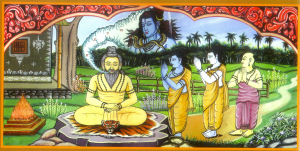Difference between revisions of "Vyakarana Vedanga (व्याकरणवेदाङ्गम्)"
(adding content and references) |
(adding content and references) |
||
| Line 1: | Line 1: | ||
| − | {{ToBeEdited}}Vyakarana (Samskrit: व्याकरणम्) or grammar, one of the important topics in the [[Shad Vedangas (षड्वेदाङ्गानि)|shad vedangas]], is the foundation of language and communication in the evolutionary history of human beings. In the tradition of vyakarana, one can see the origin of analysis tracing back to Vedas. There are innumerable references to language elements, structure and nature in classical literature. Evidence shows that the terminology used for language analysis has its origin in the Vedas.[[File:Niruktam Sarwang.png|thumb | + | {{ToBeEdited}}Vyakarana (Samskrit: व्याकरणम्) or grammar, one of the important topics in the [[Shad Vedangas (षड्वेदाङ्गानि)|shad vedangas]], is the foundation of language and communication in the evolutionary history of human beings. In the tradition of vyakarana, one can see the origin of analysis tracing back to Vedas. There are innumerable references to language elements, structure and nature in classical literature. Evidence shows that the terminology used for language analysis has its origin in the Vedas.[[File:Niruktam Sarwang.png|thumb|'''Maheshvara Sutras emanating from Guru''' Courtesy: Book "Sarwang" Published by Adivasi Lok Kala Evam Boli Vikas Academy, Madhya Pradesh Sanskriti Parishad|link=http://dharmawiki.org/index.php/File:Niruktam_Sarwang.png]] |
| − | == Origin of | + | == Origin and History of Vyakarana == |
| − | Gopathabrahmana mentions<blockquote>ओंकारं पृच्छामः। को धातुः। किं प्रातिपदिकम्। किं नामाख्यातम्। किं लिङ्गम्। किं वचनम्। का विभक्तिः। कः प्रत्ययः। कः स्वर उपसर्गो निपातः। किं वै व्याकरणम्। को विकारः। को विकारी। कतिमात्रः। कतिवर्णः। कत्यक्षरः। कतिपदः। कः संयोगः। किं स्थानानुप्रदानकरणं। (Gopa. Brah. 1.1.24)<ref>Gopatha Brahmana ([https://sa.wikisource.org/wiki/%E0%A4%97%E0%A5%8B%E0%A4%AA%E0%A4%A5_%E0%A4%AC%E0%A5%8D%E0%A4%B0%E0%A4%BE%E0%A4%B9%E0%A5%8D%E0%A4%AE%E0%A4%A3%E0%A4%AE%E0%A5%8D/%E0%A4%AA%E0%A5%82%E0%A4%B0%E0%A5%8D%E0%A4%B5_%E0%A4%AD%E0%A4%BE%E0%A4%97%E0%A4%83 Purvabhaga])</ref></blockquote> | + | In Rigveda (also in Atharvaveda, Taittriya Aranyaka and Shatapatha Brahmana) we come across the four fold division of Vak (वाक्) an important aspect of Vyakarana.<blockquote>चत्वारि वाक्परिमिता पदानि तानि विदुर्ब्राह्मणा ये मनीषिणः ।</blockquote><blockquote>गुहा त्रीणि निहिता नेङ्गयन्ति तुरीयं वाचो मनुष्या वदन्ति ॥४५॥ (Rig. Veda. 1.164.45)</blockquote>Gopathabrahmana of Atharvaveda mentions many terms that we use in vyakarana even today.<blockquote>ओंकारं पृच्छामः। को धातुः। किं प्रातिपदिकम्। किं नामाख्यातम्। किं लिङ्गम्। किं वचनम्। का विभक्तिः। कः प्रत्ययः। कः स्वर उपसर्गो निपातः। किं वै व्याकरणम्। को विकारः। को विकारी। कतिमात्रः। कतिवर्णः। कत्यक्षरः। कतिपदः। कः संयोगः। किं स्थानानुप्रदानकरणं। (Gopa. Brah. 1.1.24)<ref>Gopatha Brahmana ([https://sa.wikisource.org/wiki/%E0%A4%97%E0%A5%8B%E0%A4%AA%E0%A4%A5_%E0%A4%AC%E0%A5%8D%E0%A4%B0%E0%A4%BE%E0%A4%B9%E0%A5%8D%E0%A4%AE%E0%A4%A3%E0%A4%AE%E0%A5%8D/%E0%A4%AA%E0%A5%82%E0%A4%B0%E0%A5%8D%E0%A4%B5_%E0%A4%AD%E0%A4%BE%E0%A4%97%E0%A4%83 Purvabhaga])</ref></blockquote>Meaning: Let us analyse Omkara, what is the dhatu? what is pratipadika? what is nama and akhyata? what is lingam ? what is vibhakti ? what is pratyaya? what is svara, upasarga, nipata? what is vyakarana? what is vikara? what is vikari and how many matras? how many varnas? how many aksharas? how many pada-s? what is samyoga? what is staana-naada-anupradana and anukaranam? |
| + | |||
| + | Apart from Gopatha Brahmana, Maitrayana samhita and Aitareya Brahmana also discusses different vibhaktis. | ||
| + | |||
| + | == References == | ||
[[Category:Vedangas]] | [[Category:Vedangas]] | ||
| + | <references /> | ||
Revision as of 15:54, 6 July 2020
| This article needs editing.
Add and improvise the content from reliable sources. |
Vyakarana (Samskrit: व्याकरणम्) or grammar, one of the important topics in the shad vedangas, is the foundation of language and communication in the evolutionary history of human beings. In the tradition of vyakarana, one can see the origin of analysis tracing back to Vedas. There are innumerable references to language elements, structure and nature in classical literature. Evidence shows that the terminology used for language analysis has its origin in the Vedas.
Origin and History of Vyakarana
In Rigveda (also in Atharvaveda, Taittriya Aranyaka and Shatapatha Brahmana) we come across the four fold division of Vak (वाक्) an important aspect of Vyakarana.
चत्वारि वाक्परिमिता पदानि तानि विदुर्ब्राह्मणा ये मनीषिणः ।
गुहा त्रीणि निहिता नेङ्गयन्ति तुरीयं वाचो मनुष्या वदन्ति ॥४५॥ (Rig. Veda. 1.164.45)
Gopathabrahmana of Atharvaveda mentions many terms that we use in vyakarana even today.
ओंकारं पृच्छामः। को धातुः। किं प्रातिपदिकम्। किं नामाख्यातम्। किं लिङ्गम्। किं वचनम्। का विभक्तिः। कः प्रत्ययः। कः स्वर उपसर्गो निपातः। किं वै व्याकरणम्। को विकारः। को विकारी। कतिमात्रः। कतिवर्णः। कत्यक्षरः। कतिपदः। कः संयोगः। किं स्थानानुप्रदानकरणं। (Gopa. Brah. 1.1.24)[1]
Meaning: Let us analyse Omkara, what is the dhatu? what is pratipadika? what is nama and akhyata? what is lingam ? what is vibhakti ? what is pratyaya? what is svara, upasarga, nipata? what is vyakarana? what is vikara? what is vikari and how many matras? how many varnas? how many aksharas? how many pada-s? what is samyoga? what is staana-naada-anupradana and anukaranam?
Apart from Gopatha Brahmana, Maitrayana samhita and Aitareya Brahmana also discusses different vibhaktis.
References
- ↑ Gopatha Brahmana (Purvabhaga)

